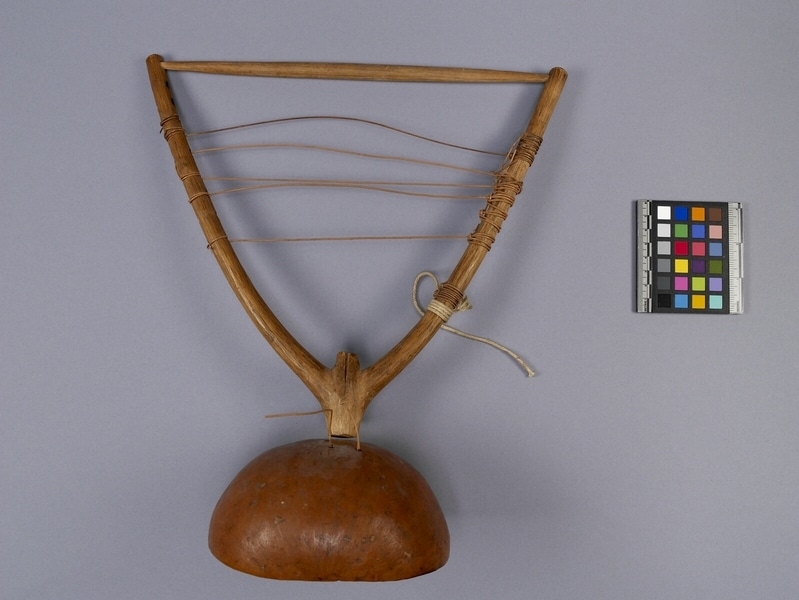Stringed Musical Instrument Item Number: Af500 a-b from the MOA: University of British Columbia

Description
Gourd harp-like instrument. Forked piece of branch (part b), with a straight section of equal length to that of the forks, and with a stick going across the top creating a triangular frame. One side has nine holes pierced through by burning. Five grass strings are tied into five of them and go to the opposite side and wind around the stick. Piece of cord around unpierced end. Separated from frame is half of a brown-yellow gourd (part a), of which the top centre has four pierced holes on it with cracks around them, and grass going through two holes at the base of the gourd.
History Of Use
Forked obah or harp is a simpler version of the lyre. The sound board in this case is half of a dried gourd which the player places against his body to vary the tonal effects. The strings are plucked with the fingers. The obah is used as a solo or as an accompanying instrument. It is important for entertainment and is integral to many rituals and ceremonies, especially those connected with birth, initiation, marriage, and death. A player is trained young, in order to perform well.
Cultural Context
Entertainment; festival.
Item History
- Made in Liberia before 1974
- Collected during 1974
- Owned by Isabell Wintemute before May 31, 1977
- Received from Isabell Wintemute (Donor) on May 31, 1977
What
- Name
- Stringed Musical Instrument
- Identification Number
- Af500 a-b
- Type of Item
- musical instrument
- Material
- gourd fruit, wood and grass
- Manufacturing Technique
- pierced, tied, hollowed and cut
- Part A
- height 9.8 cm, width 14.5 cm, depth 14.0 cm
- Part B
- height 2.4 cm, width 30.4 cm, depth 27.0 cm
Who
- Culture
- West African
- Previous Owner
- Isabell Wintemute
- Received from
- Isabell Wintemute (Donor)
Where
- Holding Institution
- MOA: University of British Columbia
- Made in
- Liberia
When
- Creation Date
- before 1974
- Collection Date
- during 1974
- Ownership Date
- before May 31, 1977
- Acquisition Date
- on May 31, 1977
Other
- Condition
- poor
- Accession Number
- 0443/0001 a-b